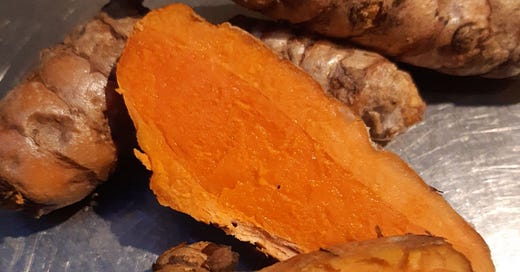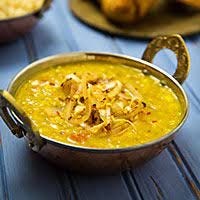Find more newsletters with opinions and recipes here. If you want to take issue, please Comment.
My kitchen is bright yellow. Not painted in a fashionable shade from the Farrow & Ball canon of colours but stained by fresh turmeric. My fingertips look like I’ve been a two-pack a day smoker for decades. My best t-shirt appears to have breakfast egg yolk down its front. My stainless steel worktop reflects a sunset (how is that possible? Don’t even ask about the state of the wood section). My grater, my mugs, my strainer - every implement that has come in contact with this rhizome cousin of ginger looks jaundiced.
An always thoughtful friend (you know who you are, CCM) ferried round some fresh turmeric root, extolling its health benefits. She drinks it first thing, grated into hot water. I’m never going to give up my opening double-shot espresso (see The Chips Are Down) for a glass of what looks like bull’s urine. But I gave it a go around the eleven a.m. slump. With a pungent taste suggestive of drawer-lining newspapers stewed with white pepper, while it wasn’t unpleasant, particularly when bolstered with fresh ginger and lemon juice, I shall never submit to becoming a terminally hipster turmeric latte ‘golden milk’ victim.
Suddenly it’s been decided for us that turmeric is a ‘superfood’. But even if superfoods were a medically-endorsed rather than a marketing category, in the manner I’m consuming it, apparently this isn’t in the least. To function therapeutically, it requires exposure to fat. Thus the ‘latte’ delivery system and not the ‘tea’ I’m drinking.
Before you go rushing out to buy your supply of finger stain, be aware that the scientific jury, as opposed to followers of Gwyneth Paltrow, is out on the health properties of turmeric when used as a drink.
Turmeric - or rather the curcumin it contains, which gives it its ochre shade - is used in India as a colourant, a depilatory, and skin treatment. 4000 years ago, it was revered as a curative in the Vedic culture. Medicine has progressed a tad since then.
While most commonly a key ingredient in curries, turmeric has traditionally been used across the Asian continent to treat inflammatory disorders. The yellow finger-and-clothes-staining rhizome is believed to be an effective antiseptic, good for the digestion, and to relieve pains in the joints.
With its New Age adoption in the west, fresh turmeric has been subjected to countless scientific trials, to substantiate claims it might cure inflammatory disorders from asthma, multiple sclerosis and IBS (irritable bowel syndrome) to cancer while preventing rheumatoid arthritis and osteoporosis.
It’s the curcuminoids, tiny molecules in turmeric, that contain its beneficial properties. Some of the thousands of scientific papers that have examined both in the lab have produced promising results. However, testing has only been done using unrealistically high doses, in test tubes or on mice. Neither are good representations of the human body. We are not rats - at least not physically.
Kathryn Nelson, research assistant professor at the University of Minnesota’s Institute for Therapeutics Discovery and Development, became curious about the health claims associated with curcumin. Adding compounds to it in test tubes, she found it a “terrible” drug molecule. Among other negatives, it was poorly absorbed, was rapidly metabolised and eliminated, and as a result didn’t actually do much.
What it needed was ‘extras’. For instance, adding black pepper, which contains piperine, increased its absorption by 2000%. Will you be asking for freshly ground black pepper with that turmeric latte? Because consuming turmeric by itself doesn’t seem to amount to much.
Drinking it for health in the far east seems to be more the equivalent of chicken soup as a cure for a cold or a milky hot drink before bed - panaceas that make us feel better in soul, if not in body.
Where turmeric does seem to have a positive medicinal effect is when it is heated up and meets fat, as in curries where it is fried in oil. Curcumin is a fat-soluble compound, meaning if you cook turmeric with fat, that enhances its absorption.
So forget Turmeric Lattes unless you love them. Go back to Flat Whites (I order a double Flat White which I call a Duplex - geddit? You may have to be American to understand…) and cook this dhal to deal with your health hopes. Whatever the health giving properties of turmeric, fresh green chilies are rich in vitamins A and C and contain a compound that stimulates the endorphins in the brain to make you feel good. Garlic is said to purify the blood, as is onion. Fresh ginger is high in potassium.
Don’t be fazed by the long list of ingredients. Putting them together to make the dish is very short work.
Masoor Dhal
Serve 4-6
200g/7 ounces red split lentils (masoor dhal)
850ml/1¾ pints water
2 slices ginger, unpeeled 6.5mm/¼ inch thick
1 fresh green chili, finely sliced
1 tablespoon freshly grated turmeric or 1 teaspoon ground turmeric
200g/7 ounces spinach (optional)
1 teaspoon whole cumin seeds
1 teaspoon ground coriander seeds
3 tablespoons vegetable oil
Juice 1 fresh lime
2 tablespoons finely chopped fresh coriander/cilantro
Salt to taste
Put the lentils and water in a heavy bottomed pan and bring to a simmer, removing any foam that rises.
Add the ginger, chili and turmeric and stir, then cover with the lid slightly askew to let steam escape and simmer on low heat for 1 ½ hours till lentils are soft, stirring regularly towards the end as the liquid reduces to prevent sticking. Stir in the spinach and wilt it. (This isn’t authentic, but it’s pretty nice.)
Heat the oil in a frying pan and add the cumin seeds. When they start popping, add the coriander seeds, stir, scrape the whole lot into the lentils pan and stir.
Stir in the lime juice, add salt if necessary, then pour into a bowl, scatter over cilantro leaves or some thinly sliced onions fried separately till crisp, and serve with boiled rice and a salad of finely sliced white cabbage and tomatoes dressed with lemon juice and salt to taste. Or eat it by the spoon on its own in your comfiest armchair.






Bit worried at idea chicken soup against a cold is merely a placebo. That's 3 millenia of Jewish penicillin binned?
Another brilliant, funny piece from Julia!